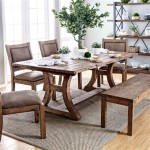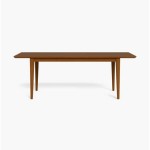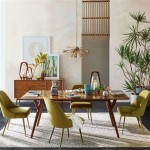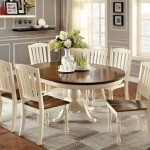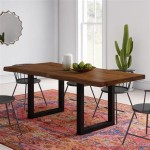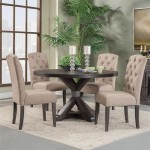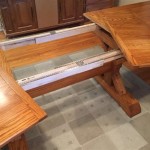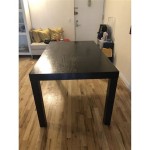Wooden Dining Table Set For 8: A Comprehensive Guide
A wooden dining table set for 8 represents a significant investment in both the functionality and aesthetics of a home. It provides a central gathering place for family meals, social gatherings, and even work-from-home activities. Choosing the right set, however, requires careful consideration of various factors, including wood type, style, size, and overall design, to ensure long-term satisfaction and suitability for the intended space.
The selection process involves navigating a diverse market offering a wide range of options, each with its unique characteristics and benefits. Understanding these differences is crucial for making an informed decision that aligns with individual needs, preferences, and budget constraints. This article aims to provide a comprehensive overview of wooden dining table sets for 8, exploring key aspects to consider during the purchasing process.
Key Point 1: Understanding Wood Types and Their Properties
The type of wood used in constructing a dining table set significantly impacts its durability, appearance, and cost. Different wood species possess varying levels of hardness, grain patterns, and resistance to wear and tear. Understanding these properties is essential for selecting a wood that meets specific requirements and aesthetic preferences.
Hardwoods: Hardwoods are generally preferred for dining table construction due to their superior strength and longevity. Common hardwood options include:
Oak: Oak is a popular choice known for its durability, distinctive grain pattern, and versatility. It is resistant to scratches and dents, making it suitable for high-traffic areas. Oak can be stained in various colors to complement different interior design styles.
Maple: Maple is a dense and strong hardwood with a fine, uniform grain. It is lighter in color than oak and can be easily stained or painted to achieve the desired look. Maple is a good option for those seeking a contemporary or minimalist aesthetic.
Cherry: Cherry wood is prized for its rich, reddish-brown color and smooth texture. It is a durable hardwood that develops a beautiful patina over time. Cherry is often used in traditional and formal dining room settings.
Walnut: Walnut is a luxurious hardwood with a deep, chocolate-brown color and intricate grain patterns. It is a strong and stable wood that is resistant to warping and cracking. Walnut is a high-end option that adds sophistication and elegance to a dining room.
Softwoods: While less common than hardwoods, softwoods can also be used in dining table construction, often in combination with hardwoods or as accents. Common softwood options include:
Pine: Pine is a readily available and affordable softwood with a light color and prominent grain. It is relatively soft and susceptible to dents and scratches, but it can be treated with protective finishes to improve its durability. Pine is often used in rustic or farmhouse-style dining tables.
Fir: Fir is another softwood option that is known for its straight grain and light color. It is slightly harder than pine and offers better resistance to wear and tear. Fir is often used in contemporary and Scandinavian-inspired dining tables.
Beyond the core wood type, the construction method also matters. Solid wood tables are made from single pieces of lumber, offering superior strength and longevity. Veneered tables, on the other hand, consist of a thin layer of wood adhered to a substrate like plywood or particleboard. While veneered tables can be more affordable, they may not be as durable or resistant to damage as solid wood tables.
Key Point 2: Styles and Designs to Complement Your Home
The style of a dining table set should complement the overall aesthetic of the home. There is a wide range of styles available, from traditional to contemporary, each with its unique characteristics and design elements. Selecting the right style can enhance the visual appeal of the dining room and create a cohesive look.
Traditional: Traditional dining tables often feature ornate details, such as carved legs, intricate moldings, and rich wood finishes. They evoke a sense of formality and elegance, often incorporating elements from historical furniture styles like Queen Anne or Chippendale. Fabrics such as velvet or damask are common choices for accompanying chairs.
Contemporary: Contemporary dining tables are characterized by clean lines, minimalist designs, and a focus on functionality. They often feature geometric shapes, sleek surfaces, and neutral colors. Materials such as metal, glass, and engineered wood are frequently used in conjunction with wood. Simple, upholstered chairs or even molded plastic chairs may be paired with contemporary tables.
Modern: Modern dining tables typically emphasize simplicity and functionality, often drawing inspiration from mid-century modern design. They may feature tapered legs, clean lines, and a minimalist aesthetic. Natural wood finishes and organic shapes are common elements. Simple, elegant chairs with clean lines and minimal ornamentation are often selected to complement modern tables.
Rustic/Farmhouse: Rustic and farmhouse-style dining tables are characterized by their natural, weathered appearance and emphasis on handcrafted details. They often feature reclaimed wood, distressed finishes, and exposed joinery. Benches or mismatched chairs are frequently used to complete the rustic look.
Industrial: Industrial dining tables combine raw materials like wood and metal to create a rugged and utilitarian aesthetic. They often feature exposed metal legs, distressed wood surfaces, and functional hardware. Chairs with metal frames and leather or canvas upholstery are commonly paired with industrial tables.
Beyond the overall style, the shape of the table also plays a significant role in the dining room's layout and functionality. Rectangular tables are the most common choice, offering ample seating and a classic look. Round tables promote conversation and create a more intimate dining experience. Oval tables combine the benefits of rectangular and round tables, providing ample seating while maintaining a sense of intimacy. Square tables are suitable for smaller dining rooms and can be extended with leaves to accommodate more guests.
Key Point 3: Size and Space Considerations for 8-Seat Dining Tables
Choosing the right size dining table is crucial for ensuring comfortable seating and adequate space for movement within the dining room. A dining table set for 8 requires sufficient space to accommodate the table itself, as well as the chairs and surrounding walkways.
A standard dining table set for 8 typically requires a table that is at least 72 inches (6 feet) long and 36 inches wide. However, the exact dimensions may vary depending on the style and design of the table. It is essential to measure the dining room space carefully before purchasing a table to ensure that it fits comfortably without overcrowding the room.
Consider these space planning guidelines:
Clearance: Allow at least 36 inches of clearance between the edge of the table and any walls or furniture to allow for comfortable seating and movement. Ideally, a clearance of 42-48 inches is preferable for ease of movement, especially behind seated diners.
Chair Placement: Account for the space required for chairs to be pulled out and pushed back. When chairs are pulled out, they typically require an additional 18-24 inches of space.
Room Shape: The shape of the dining room can also influence the choice of table shape. Rectangular tables are well-suited for long, narrow rooms, while round or oval tables may be a better fit for square rooms.
Extending Tables: If space is limited, consider an extending dining table that can be expanded with leaves to accommodate more guests when needed. These tables are ideal for smaller dining rooms that occasionally host larger gatherings.
Chair Style: The size and style of the chairs can also impact the overall space requirements. Armchairs, for example, require more space than armless chairs. Ensure that the chairs are proportioned to the table and that they fit comfortably underneath when not in use.
In addition to the table and chairs, consider the placement of other furniture in the dining room, such as sideboards, buffets, or china cabinets. These pieces should be positioned in a way that does not obstruct walkways or create a cramped feeling.
Ultimately, selecting a wooden dining table set for 8 involves a careful evaluation of wood type, style, and size considerations. By understanding these factors, individuals can make an informed decision that aligns with their specific needs, preferences, and the overall design of their home.

Rustic 8 Ft Santa Rita Dining Set

Kitchen Table Dining Set Bench Oak Wood Small To 8 Seater Space Saving Wooden Scandi 4 Seat Chairs Rustic Reclaimed Narrow Farmhouse Modern

Rectangular Wooden Dining Table Set 8 Seater At 125000 In Saharanpur Id 2853059116273

Nova Heidi 8 Seat Rectangular Wood Effect Patio Set

Furniture Of America Cabone 120 In Rectangle Brown Cherry Wood Dining Table With Extension Leaf Seats 8 Idf 3147t The Home

8 Seater Dining Set The Ultimate Ing Guide Furniture Outlet

Dining Table Set Wooden In Best Designs Furniture For Every Home Sunrise International

Redford 8 Seater Wooden Top Dining Set Home Centre Bahrain

Dining Table Set Wooden In Best Designs Furniture For Every Home Sunrise International

Adolph 8 Seater Dining Table Set Honey Finish 31 Off Wooden Street

